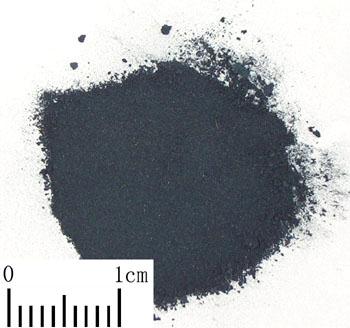Indigo Naturalis
The Processing of Indigo Naturalis
Origin
A kind of dried powder or clumping processed from the leaf or stem with leaf of Baphicacanthus cusia (Nees) Bremek, Polygonum tinctorium Ait or Isatis indigotica Fort. of family Acanthaceae.
Location
Fujian, Yunnan, Jiangsu, Anhui, Hebei provinces, etc. in China. The one produced in Fujian named Jian Qing Dai is the best in quality.
Harvest
The stems and leaves are cut in summer and autumn and kept soaking in water until leaves are decayed and stems are decorticated which are threw away then; proper dose of lime cream is added into the infusion which is stirred thoroughly till the color changed from dark green to deep red, dried after giving away the surface foam.
The actual smell and taste
Slightly grassy smell and bland taste.
Best quality
Fine powder, blue in color, light and loose in quality, being able to float in the water, purplish red flame while burning.
The Effect of Indigo Naturalis
Property
Bitter, salty, cold; liver, heart, lung and stomach meridians entered.
Actions
Clear heat and remove toxicity, cool blood, and clear liver-fire.
Indications
A. Macula due to epidemic toxicity
It is the processed products of Da Qing Ye, and has a similar action of clearing heat, removing toxicity and cooling blood to that of Da Qing Ye. Because of the inferior action of removing toxicity and relieving fever, it is not used as widely as Da Qing Ye in treating warm disease, and only used to treat warm disease under circumstances of macula due to epidemic toxicity. It can be used alone, for example, it is used singly to treat cold pathogenic disease with reddish macules in book of Lei Zheng Huo Ren Shu (Classified Cure Book); and it can also be combined with heat-clearing and fire-purging, blood-cooling, and toxicity-removing herbs to improve the effects, as in Qing Dai Shi Gao Tang from Chong Ding Tong Su Shang Han Lun (Newly Revised Common Treatise on Cold-Induced Disease), Shi Gao, Sheng Di Huang, Sheng Ma and Huang Qin are used in combination.
B. Syndromes of heat-toxicity manifested as sore throat, mouth ulcer, sores and mumps
For the actions of clearing heat and removing toxicity, cooling blood and relieving swelling, it is also indicated for many kinds of heat-toxicity syndromes, and can be used in either oral or topical administration. For excessive heat-toxicity manifested as swollen and sore throat, ulcer, swelling, pain or rottenness of mouth and tongue, it is often combined with other herbs for clearing heat and removing toxicity, relieving swelling and stopping pain, such as Niu Huang and Bing Pian, as in Xi Lei San from Jin Kui Yao Lue Bu Yi (Supplements to Commentaries on the Synopsis of the Golden Chamber), they are used in powder which is blown into the infected region. For sores and ulcers due to heat-toxicity, it can be smeared alone or combined with other heat-clearing, toxicity-removing, and fire-purging herbs, as in Qing Jin San from Pu Ji Fang, it is pounded with Han Shui Shi and applied topically to enhance the effects of removing toxicity, relieving swelling and stopping pain; it takes much better effects in treating sores and abscess due to heat-toxicity when combined with heat-clearing, toxicity-removing, and dampness-drying herbs, for example, Huang Lian and Huang Bai, etc. For mumps, it can be used either orally or topically, as in Ling Nan Cai Yao Lu (Records of Herb Collection in Lingnan), it is smeared alone; the effects get better when it is combined with Ban Lan Gen and Da Qing Ye, etc.
C. Bleeding due to blood heat
With the actions of clearing heat and cooling blood, it is indicated for various kinds of bleeding syndromes due to blood heat. It can be used alone, and also usually combined with heat-clearing, blood-cooling, and bleeding-stopping herbs to improve the effects.
For incessant hematemesis, it is used singly in Qing Jin San from Duan Xiao Fang (Proper Effect Prescriptions). For hemoptysis, it is combined with blood-cooling and bleeding-stopping herbs, such as Zhi Zi, etc. , as in Ke Xue Fang from Dan Xi Xin Fa; and it is combined with Xing Ren, as in Sheng Bing Zi from Zhong Cang Jing (Treasured Classic). For epistaxis, its powder can be dipped with sterilized cotton and stuffed into nasal cavity to press the bleeding region.
D. Cough with hemoptysis
It can clear heat from both lung and liver, and also has a combined action of cooling blood. It is commonly used to treat impairment of lung collaterals due to invasion of lung by liver fire which is manifested as cough, chest pain, hemoptysis or phlegm with blood, and often combined with phlegm-resolving and cough-stopping herbs, as in Dai Ge San from Wei Sheng Hong Bao (A Great Precious Sanitation). Hai Ge Ke powder is used together to mutually take effects of clearing lung-heat and resolving phlegm, stopping cough and bleeding. For cough with thick yellow sputum due to lung heat, it can be combined with heat-clearing and phlegm-resolving herbs. For example, Hai Fu Shi, Gua Lou Ren and Chuan Bei Mu are combined as in Qing Dai Hai Shi Wan from Zheng Yin Mai Zhi ( Treatment based on symptom-Cause-Pulse).
E. Convulsions due to liver-heat
With the action of clearing liver-heat, it is indicated for infants with wind generation by liver-heat, convulsions and epilepsy. Because it hasn't the action of extinguishing wind and stopping convulsions, it has to be combined with heat-clearing, wind-extinguishing and convulsions-stopping herbs, such as Gou Teng and Niu Huang, as in Liang Jing Wan from Xiao'er Yao Zheng Zhi Jue.
Dosage and Administrations
Take l.5~3g orally. It should be used in pill and powder except decoction because it is insolvable in water which can result in the cloudy liquid and difficult filtration. Proper dosage is for sprinkling with dried powder or applying with paste.
